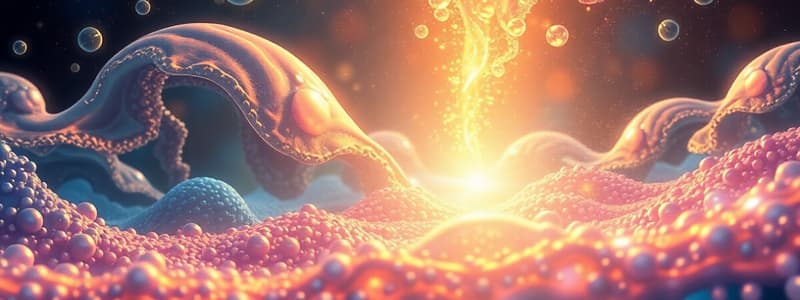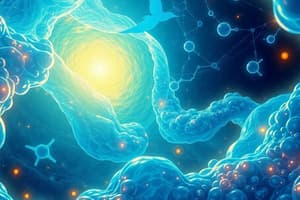Podcast
Questions and Answers
What is the primary observation that indicates the presence of glycerol when conducting the Acrolein Reaction?
What is the primary observation that indicates the presence of glycerol when conducting the Acrolein Reaction?
- Color change to bright red
- Formation of a white precipitate
- Disappearance of iodine
- Pungent odor and blackening of the mixture (correct)
In the Iodine Reaction, what is the significance of iodine remaining brown?
In the Iodine Reaction, what is the significance of iodine remaining brown?
- Shows a positive result for cholesterol
- Indicates the presence of glycerol
- Confirms that the lipid is saturated (correct)
- Signifies the presence of unsaturated fatty acids
What does the Emulsion Test detect regarding lipids?
What does the Emulsion Test detect regarding lipids?
- The concentration of fatty acids
- Presence of lipids indicated by a cloudy white emulsion (correct)
- The degree of saturation of the lipid
- The solubility of lipids in polar solvents
What is the main outcome of the Saponification Test?
What is the main outcome of the Saponification Test?
Which statement correctly describes the Solubility Test for lipids?
Which statement correctly describes the Solubility Test for lipids?
Which of the following correctly describes the solubility characteristics of non-saponifiable lipids?
Which of the following correctly describes the solubility characteristics of non-saponifiable lipids?
Which class of lipids primarily serves as structural components of cell membranes?
Which class of lipids primarily serves as structural components of cell membranes?
What is the common characteristic of saturated fatty acids?
What is the common characteristic of saturated fatty acids?
Which of the following is an example of a complex lipid?
Which of the following is an example of a complex lipid?
Which of the following lipids is a derivative of a common four-ring structure?
Which of the following lipids is a derivative of a common four-ring structure?
What is a unique feature of prostaglandins compared to leukotrienes?
What is a unique feature of prostaglandins compared to leukotrienes?
Which of the following best describes the structural composition of waxes?
Which of the following best describes the structural composition of waxes?
Which type of fatty acids remains liquid at room temperature?
Which type of fatty acids remains liquid at room temperature?
What is the primary function of cholesterol in animal cells?
What is the primary function of cholesterol in animal cells?
Which type of lipid contains a phosphate group?
Which type of lipid contains a phosphate group?
What indicates a higher degree of unsaturation in fatty acids when reacting with iodine?
What indicates a higher degree of unsaturation in fatty acids when reacting with iodine?
What is the result of hydrogenation of unsaturated fatty acids?
What is the result of hydrogenation of unsaturated fatty acids?
Which reaction tests for cholesterol using acetic anhydride and sulfuric acid?
Which reaction tests for cholesterol using acetic anhydride and sulfuric acid?
What contributes to the rancidity of fats or oils?
What contributes to the rancidity of fats or oils?
What is a characteristic of acrolein formed during lipid hydrolysis?
What is a characteristic of acrolein formed during lipid hydrolysis?
What type of lipid is characterized by containing a sugar group?
What type of lipid is characterized by containing a sugar group?
Flashcards
What are lipids?
What are lipids?
Lipids are a diverse group of organic compounds that are insoluble in water but can be dissolved in nonpolar solvents like ether and chloroform.
What are the main functions of lipids?
What are the main functions of lipids?
The primary role of lipids is to store energy within the body. They are also crucial components of cell membranes, providing structural support and regulating permeability.
What are simple lipids?
What are simple lipids?
Simple lipids are formed by the combination of fatty acids and their derivatives, such as glycerol. Examples include fats, oils, and waxes like palm oil and olive oil.
What are complex lipids?
What are complex lipids?
Signup and view all the flashcards
What are phospholipids and where are they found?
What are phospholipids and where are they found?
Signup and view all the flashcards
What are sphingolipids and where are they found?
What are sphingolipids and where are they found?
Signup and view all the flashcards
What are glycolipids and where are they found?
What are glycolipids and where are they found?
Signup and view all the flashcards
What are steroids and give some examples?
What are steroids and give some examples?
Signup and view all the flashcards
Hydrolysis of Lipids
Hydrolysis of Lipids
Signup and view all the flashcards
Hydrogenation of Lipids
Hydrogenation of Lipids
Signup and view all the flashcards
Rancidity
Rancidity
Signup and view all the flashcards
Acrolein Formation
Acrolein Formation
Signup and view all the flashcards
Reaction to Iodine
Reaction to Iodine
Signup and view all the flashcards
Cholesterol
Cholesterol
Signup and view all the flashcards
Glycolipids
Glycolipids
Signup and view all the flashcards
Phospholipids
Phospholipids
Signup and view all the flashcards
Acrolein Reaction
Acrolein Reaction
Signup and view all the flashcards
Iodine Reaction
Iodine Reaction
Signup and view all the flashcards
Solubility Test
Solubility Test
Signup and view all the flashcards
Emulsion Test
Emulsion Test
Signup and view all the flashcards
Saponification Test
Saponification Test
Signup and view all the flashcards
Study Notes
Chemistry of Lipids
- Lipids are diverse compounds insoluble in water, but soluble in nonpolar solvents.
- Major functions include energy storage and membrane structure.
Classes of Lipids
- Simple Lipids: Composed of fatty acids and their derivatives.
- Examples: fats, oils, waxes
- Complex Lipids: Contain additional components like phosphates, sugars, or amino groups.
- Subtypes:
- Phospholipids: Major membrane components, e.g., phosphatidylcholine
- Sphingolipids: Important in nerve tissues and cell membranes
- Glycolipids: Contain a sugar group; found in cell membranes, notably in the nervous system
- Subtypes:
- Steroids: Derived from a common four-ring structure.
- Cholesterol: A crucial component in cell membranes and a precursor for steroid hormones.
Other Lipid Groups and Types
- Prostaglandins & Leukotrienes: Signaling molecules involved in inflammation, pain, fever, allergic reactions, and immune response.
- Steroid Hormones: Regulate metabolic processes and reproduction (e.g. testosterone, estrogen)
Classification Based on Solubility
- Saponifiable Lipids: Hydrolyzed by alkaline solutions (e.g., fats, oils, and waxes)
- Non-saponifiable Lipids: Cannot be hydrolyzed by alkaline solutions (e.g., steroids, prostaglandins)
Building Blocks of Lipids
- Glycerol: A three-carbon compound with three hydroxyl groups. Serves as a site for esterification with fatty acids.
- Fatty Acids: Carboxylic acids with long aliphatic chains. Classified as saturated or unsaturated based on the presence of double bonds.
Special Types of Lipids
- Waxes: Formed from long-chain fatty acids esterified with a monohydric alcohol. Used in various applications like ointments, polishes and creams.
Chemical Properties of Lipids
- Hydrolysis: Lipids break down into fatty acids and glycerol in the presence of specific enzymes or strong acids.
- Rancidity: Results from hydrolysis and oxidation of fats and oils, characterized by an unpleasant odor and taste.
- Hydrogenation: Conversion of oils (liquid) to fats (solid) by adding hydrogen to unsaturated fatty acids.
- Acrolein Formation: During hydrolysis, glycerol can break down into acrolein which is identifiable by a pungent odor. This occurs when fats or oils are burned.
- Reaction with Iodine: Unsaturated fatty acids react with iodine; the amount that reacts indicates the degree of unsaturation.
Tests for Lipids
- Liebermann-Burchard Reaction: Tests for cholesterol (color change from Pink → Lilac → Deep Green)
- Salkowski Reaction: Tests for cholesterol (observations in different layers of solution)
- Acrolein Reaction: Tests for glycerol (pungent odor/blackening)
- Iodine Reaction: Tests for saturation of lipids (disappearance of iodine = unsaturated; brown iodine = saturated).
- Solubility Test: Lipids are soluble in nonpolar solvents, but insoluble in polar ones (water).
- Emulsion Test: Formation of cloudy emulsions in a mixture of lipids, alcohol and water indicate lipid presence.
- Saponification Test: Alkaline hydrolysis of fats and oils to produce glycerol and soap.
Studying That Suits You
Use AI to generate personalized quizzes and flashcards to suit your learning preferences.




